
The die and the plate were produced by Bradbury, Wilkinson & Co. who also recess printed the stamps.
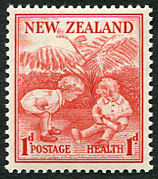
The 1938 design shows children playing on a lawn and the designer was J. Berry.
The stamps cost 2d, 1d for postage and 1d which went towards health camps for children.
The paper was Jones paper watermarked multiple NZ and star and the stamps had a comb perforation of 14 x 13½. The stamps were issued in sheets of 80 (8 rows of 10).
Dates:
- 1938 issued October 1, withdrawn 15 Feb 1939
Numbers sold:
- 1938: 1,234,720
Plate block
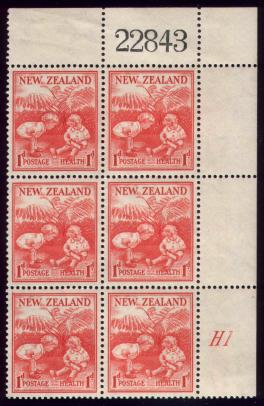
A single plate was made and the plate number H1 appears in the third row in both the left and right margins.
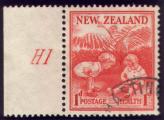
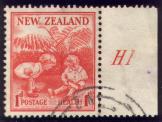
Each sheet had a sheet number in the top right hand corner.
First Day Covers
Again, no official first day cover was produced by the Post Office, but quite a large number of different covers were produced privately.
The date of issue of the health stamp is incorporated in the design of some of these covers, showing that the date of issue was announced
several days in advance.
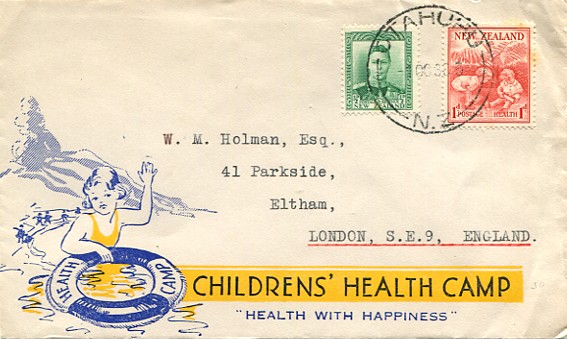
Health Federation cover postmarked in Otahuhu (Auckland) on the first day of issue, 1 October 1938, and addressed to London.
A modified version of this cover was issued in 1939.
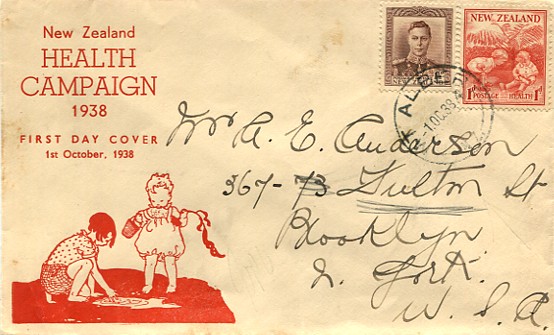
Cover postmarked in Albert on the first day of issue, 1 October 1938, and addressed to USA. Backstamped on arrival in Brooklyn on 26 October.
It depicts two children playing with seaweed.

This cover is postmarked in Napier on the first day of issue, 1 October 1938, and displays the importance of milk in a child's diet. It also exists in green and black.
The cover was designed by T Sparling and printed by Swailes Printers of Napier.
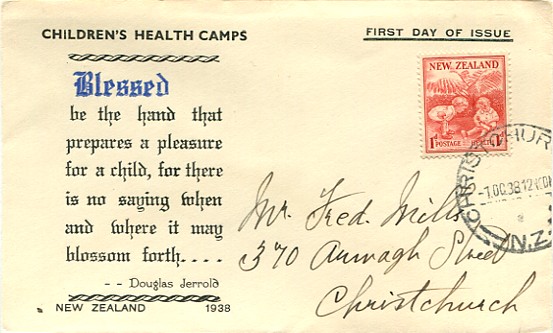
This first day cover is franked in Christchurch on the first day of issue and is addressed locally. It contains a quotation from Douglas Jerrold.
The printing on the cover includes the year of issue.
Another version of this cover exists without the year of issue.
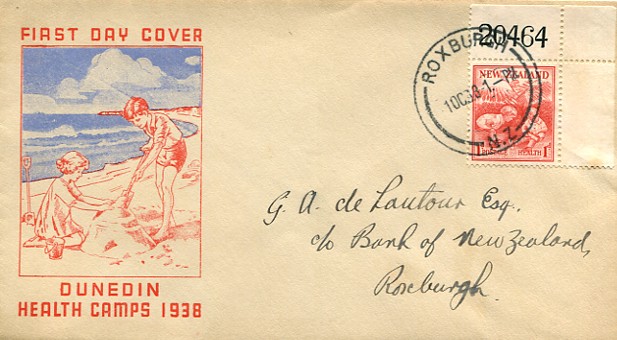
Local Health Camp organisations privately produced covers for use on the first day of issue. This cover was produced by the Dunedin District Health Camp Committee who had also produced a cover in the previous year. Although the year is printed on the cover, the date of issue is not printed.
This cover is postmarked in Roxburgh on the first day of issue, 1 October 1938
and the stamp is from the top right position on the sheet and shows the sheet number.
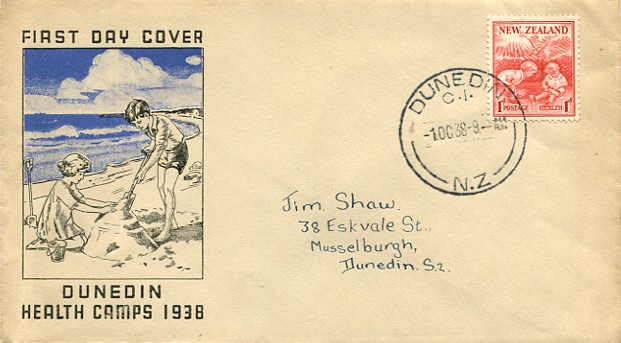
Another cover produced by the Dunedin District Health Camp Committee, but this time in blue and black while the previous cover is in blue and red.
This cover is postmarked in Dunedin on the first day of issue, 1 October 1938.
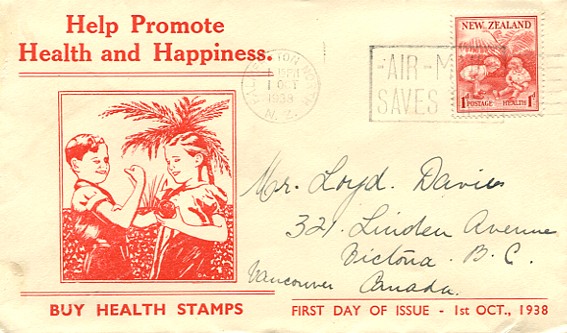
Both the year and the first day of issue are printed on this cover.
It is postmarked in Palmerston North on the first day of issue, 1 October 1938
and is addressed to Canada.
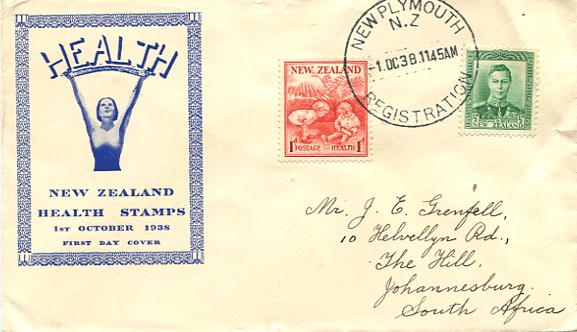
Again, both the year and the first day of issue are printed on this cover.
It is postmarked in New Plymouth on the first day of issue, 1 October 1938 and is addressed to South Africa.
It was printed by Norman Hopper of Wanganui and part of the design is similar
to a 1935 cover also printed by Hopper.
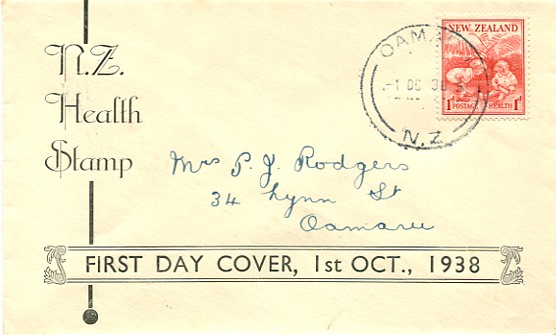
Again, both the year and the first day of issue are printed on this cover.
It is postmarked in Oamaru on the first day of issue, 1 October 1938 and is addressed locally.
Examples were almost always postmarked in, and sent to, Oamaru where the covers were produced.
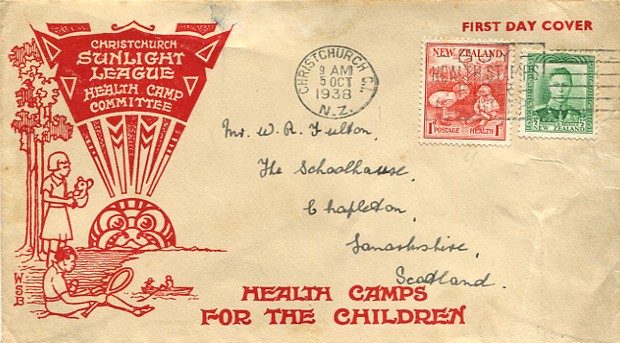
This is the only cover produced by the Sunlight League Health Camp Committee and raised funds for their camps. It was designed by William Bavestock.
Cover addressed to Scotland, but not posted on first day of issue.
The Sunlight League ran health camps in the Christchurch area from 1931 and had strict selection rules: they were only for the "daughters of the deserving poor". After they joined the Health Camp Federation in 1936, they had to adopt normal admission rules.
They were instrumental in setting up the Glenelg permanent health camp.
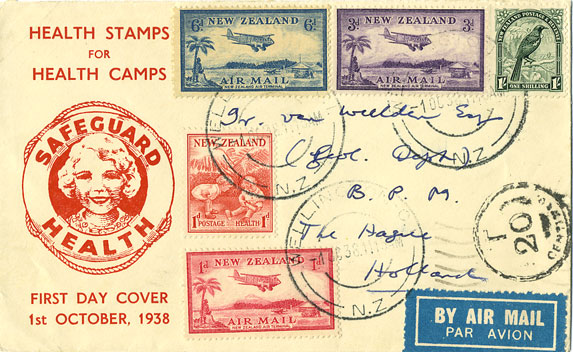
Air mail to Holland
This first day cover is franked with several other stamps as well as the 1938 Health stamp.
It is postmarked in Wellington on 1 October 1938 and addressed to Holland. Although the Empire Airmail Scheme was in operation, it did not apply to non-Empire countries.
The postage rate to Holland was 2s 0d, but this cover is only franked with 1s 11d and so has a T 20 centimes handstamp indicating that there was 2d to pay as it was underpaid by 1d. Perhaps, the sender mistakenly counted the Health stamp as counting for 2d.
The printing on the cover includes the date of issue.
The above information is taken from:
[1] The Postage Stamps of
New Zealand Vol 1, published by the
Philatelic Society of New Zealand in 1938.
[2] The Postage Stamps of
New Zealand Vol 2, published by the
Royal Philatelic Society of New Zealand in 1950.
[3] Illustrated First Day Covers of New Zealand 1933-2000, Part 1: Health,
Stephen Jones, July 2008.
All scans were made by the author.